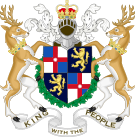Law of Florenia
| This article is part of a series on |
| Politics of Florenia |
|---|
 |
The Law of Florenia consists of a unique blend of legal systems and is grounded in the principles of direct democracy and consensus politics. Operating under neither a civil law nor common law system, the Crown Court serves as the sole judicial authority and functions in pursuit of restorative justice and reconciliation rather than issuing punitive sentences. These principles are enumerated in the Resolution on Florenian Government, the kingdom’s central constitutional document and basis of the modern state. The Crown Court is presided over by the sovereign or an appointed commissioner, though it has never convened.
Legislation in Florenia comprises various forms and has multiple origins. While acts of Parliament take precedence over all other legislation, statutes are often issued by the Crown as orders in council under the advice of the government. The government can also issue orders of council, by which the Council of State exercises powers delegated it by Parliament and the Crown. The Resolution is considered to confirm parliamentary sovereignty, allowing parliament the right to issue any law, and thereby distinguishing it as the supreme legislative body of the state.
Clause IV of the Resolution on Florenian Government stipulates that “Florenia will not have a legal system which seeks to punish offenses and will not engage in restricting the behavior by statute by and large.” As such, Florenian law is distinctly limited in nature, and it does not tend enumerate penalties for violations.
Constitution
Florenia operated under a codified constitution from 5 September 2011 until 25 November 2016 upon the promulgation of the November Declaration, a royal decree suspending Parliament and reorganizing the state. However, the 2011 constitution remained active statute law and the basis of Florenia’s governmental arrangements during this time.
The November Declaration also instructed the government to begin planning for major institutional reform. It wasn’t until September 2020 that such plans were officially announced in the form of the Resolution on Florenian Government. On 26 April 2021, the Resolution was adopted in a referendum by the Florenian public, and the 2011 constitution and system of government described therein were formally struck down.
The Prince Nathan, the author of the Resolution, intentionally opted to avoid overly specific descriptions of state bodies and functions, instead outlining broad principles to guide the kingdom and its government. This was in direct response to the lethargy in previous reform attempts due to the specificity in and restrictive nature of the previous codified constitutional system. Instead, the Resolution system allows for development and flexibility in governance, and is seen as a mere piece of an organic web of constitutional documents and conventions.
Adopted in a national referendum and calling for the establishment of a direct democratic parliament, the resolution places the ultimate legitimacy of the state and its constitutional arrangements in the public. Clause VI of the resolution requires Parliament to vote to affirm the sovereign’s reign continuing, though does not specify the outcome of an unsuccessful vote. Regardless, clause VI places great responsibility of oversight in Parliament, and, in effect, is considered to grant parliamentary sovereignty. As such, Parliament can in theory make any law and at any time decide to alter the fundamental constitutional arrangements of the kingdom, including the Resolution itself.
Current legislation
In addition to Acts of Parliament and Orders in Council, the Resolution on Florenian Government, having been adopted in a referendum, is the basis of the modern legal system and belongs to neither of these two categories.
Acts of Parliament
| Short title | Adopted | Royal assent |
|---|---|---|
| Parliament Act 2024 | 9 January 2024 | 11 January 2024 |
| Citizenship Act 2024 | 9 January 2024 | 11 January 2024 |
| New Dominion Act 2024 | 9 January 2024 | 11 January 2024 |
Orders in Council
| Title | Issued |
|---|---|
| I Eran 2021 (Parliament of Florenia) | 22 April 2021 |
| II Eran 2021 (The Council of State) | 22 April 2021 |
| III Eran 2021 (The Crown Court) | 22 April 2021 |
| IV Eran 2021 (Ministers of the Crown) | 22 April 2021 |